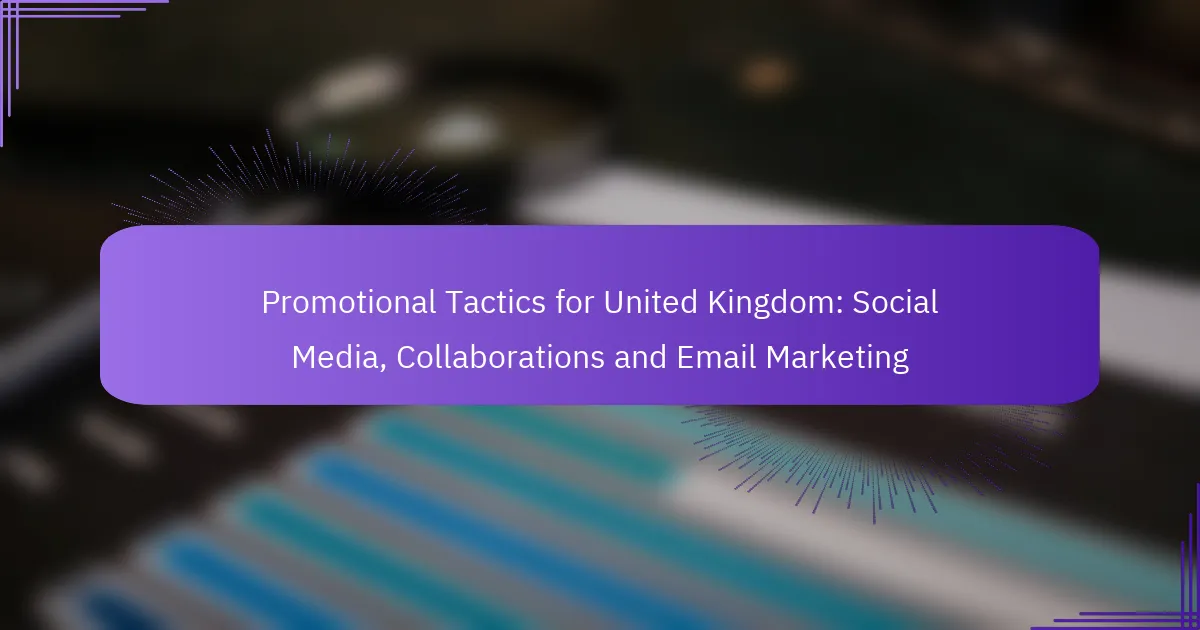In the competitive landscape of the UK market, leveraging social media, collaborations, and email marketing is essential for effective promotional tactics. Engaging content on platforms like Instagram and TikTok can boost brand visibility, while strategic partnerships allow businesses to reach wider audiences. Additionally, personalized and segmented email campaigns can enhance customer engagement and drive conversion rates, making these tactics crucial for success.

What Are Effective Social Media Tactics in the UK?
Effective social media tactics in the UK focus on engaging audiences through tailored content and strategic partnerships. Utilizing platforms like Instagram, Facebook, and TikTok can significantly enhance brand visibility and customer interaction.
Influencer partnerships
Influencer partnerships involve collaborating with individuals who have a strong following on social media to promote your brand. In the UK, micro-influencers with niche audiences can be particularly effective, as they often yield higher engagement rates compared to larger influencers.
When selecting influencers, consider their audience demographics and engagement levels. Establish clear expectations regarding deliverables, timelines, and compensation to ensure a successful collaboration.
Targeted ads on Facebook
Targeted ads on Facebook allow businesses to reach specific demographics based on interests, behaviors, and location. This precision helps in maximizing ad spend efficiency and increasing conversion rates.
To create effective ads, use eye-catching visuals and compelling copy. Monitor ad performance regularly and adjust targeting parameters or creative elements as needed to optimize results.
Engagement through Instagram Stories
Instagram Stories provide a dynamic way to engage with followers through temporary content that encourages interaction. Features like polls, questions, and countdowns can boost engagement and keep your audience invested in your brand.
Post Stories consistently and at times when your audience is most active to maximize visibility. Utilize analytics tools to track engagement metrics and refine your strategy accordingly.
Utilizing TikTok for brand awareness
Utilizing TikTok for brand awareness involves creating short, engaging videos that resonate with the platform’s younger audience. Trends and challenges can be leveraged to increase visibility and encourage user-generated content.
Focus on authenticity and creativity, as TikTok users value genuine content. Collaborating with popular TikTok creators can also amplify your reach and enhance brand credibility.
Content scheduling for peak times
Content scheduling for peak times ensures that your posts reach the maximum number of followers when they are most active. Analyzing audience insights can help identify these optimal posting times.
Use scheduling tools to automate posts and maintain a consistent presence. Experiment with different posting times and monitor engagement metrics to refine your approach over time.

How Can Collaborations Boost Marketing Efforts?
Collaborations can significantly enhance marketing efforts by leveraging the strengths and audiences of multiple brands. By partnering with others, businesses can expand their reach, share resources, and create more engaging content that resonates with a broader audience.
Co-marketing with complementary brands
Co-marketing involves partnering with brands that offer complementary products or services. This strategy allows both parties to tap into each other’s customer bases, increasing visibility and potential sales. For example, a fitness apparel brand might collaborate with a health food company to create joint promotions, benefiting from shared marketing efforts.
When planning co-marketing initiatives, ensure that the brands align in values and target demographics. This alignment fosters authenticity and enhances customer trust, making the collaboration more effective.
Joint webinars with industry experts
Hosting joint webinars with industry experts can position your brand as a thought leader while providing valuable insights to your audience. By collaborating with recognized figures, you can attract a larger audience and enhance credibility. For instance, a software company might partner with a tech influencer to discuss industry trends, drawing in participants from both audiences.
To maximize engagement, promote the webinar across all partners’ channels and consider offering exclusive content or discounts to attendees. This approach not only boosts attendance but also encourages future interactions with your brand.
Cross-promotions on social platforms
Cross-promotions on social media involve sharing each other’s content or campaigns to reach a wider audience. This tactic is effective for increasing followers and engagement. For example, a beauty brand could collaborate with a skincare line to run a giveaway, encouraging followers to engage with both brands.
When executing cross-promotions, ensure that the content is relevant and appealing to both audiences. Use clear calls to action and track engagement metrics to evaluate the success of the campaign.
Affiliate programs for mutual benefits
Affiliate programs allow businesses to partner with individuals or other companies to promote their products in exchange for a commission on sales. This model incentivizes partners to drive traffic and sales, creating a win-win situation. For example, an online retailer might set up an affiliate program for bloggers in their niche, providing them with unique discount codes to share with their audience.
When establishing an affiliate program, define clear terms and commission structures to ensure transparency and motivate partners. Regularly communicate with affiliates to provide them with updated materials and support, fostering a strong partnership.

What Email Marketing Strategies Work Best in the UK?
Effective email marketing strategies in the UK focus on personalization, segmentation, and testing to enhance engagement and conversion rates. By tailoring messages to specific audiences and continuously optimizing content, businesses can significantly improve their email performance.
Personalized email campaigns
Personalized email campaigns involve customizing content based on individual recipient preferences and behaviors. This can include addressing the recipient by name, recommending products based on past purchases, or sending tailored content that aligns with their interests. Such personalization can increase open rates and drive higher engagement.
To implement personalization effectively, use customer data to segment your audience and create relevant content. Tools like dynamic content blocks can help automate this process, ensuring each recipient receives a unique experience that resonates with them.
Segmentation for targeted messaging
Segmentation involves dividing your email list into smaller groups based on specific criteria such as demographics, purchase history, or engagement levels. This allows for targeted messaging that speaks directly to the interests and needs of each segment. For example, sending different promotions to first-time buyers versus loyal customers can enhance relevance and effectiveness.
Consider using criteria like age, location, or previous interactions to create segments. Regularly updating your segments based on new data will help maintain the effectiveness of your campaigns and ensure that your messaging remains relevant.
A/B testing subject lines
A/B testing subject lines is a method of comparing two different subject lines to determine which one performs better in terms of open rates. By sending one version to a small portion of your audience and the other to a different segment, you can gather data on which subject line resonates more effectively.
When conducting A/B tests, focus on one variable at a time, such as length, tone, or urgency. Aim for a sample size that is statistically significant to ensure reliable results, and use the insights gained to refine future campaigns.
Automated follow-up sequences
Automated follow-up sequences are pre-scheduled emails that are triggered by specific actions taken by the recipient, such as signing up for a newsletter or abandoning a shopping cart. These sequences help nurture leads and maintain engagement over time without requiring constant manual effort.
To create effective automated sequences, map out the customer journey and identify key touchpoints where follow-ups would be beneficial. Ensure that the content is relevant and provides value, encouraging recipients to take the next step in their engagement with your brand.

What Are the Key Metrics to Measure Success?
Key metrics to measure success in promotional tactics include open rates, click-through rates, conversion rates, and engagement metrics. These indicators help assess the effectiveness of social media, collaborations, and email marketing campaigns in the United Kingdom.
Open rates
Open rates indicate the percentage of recipients who open an email compared to the total number of emails sent. A typical open rate for email marketing in the UK ranges from 15% to 25%, depending on the industry and audience engagement.
To improve open rates, consider crafting compelling subject lines and personalizing emails. Avoid spammy language and ensure your sender name is recognizable to increase trust and encourage opens.
Click-through rates
Click-through rates (CTR) measure the percentage of users who click on a link within an email or social media post. A good CTR in the UK usually falls between 2% and 5%, but this can vary based on the type of content and audience targeting.
Enhance CTR by including clear calls-to-action (CTAs) and ensuring that links are easily accessible. A/B testing different formats and placements can help identify what resonates best with your audience.
Conversion rates
Conversion rates represent the percentage of users who complete a desired action, such as making a purchase or signing up for a newsletter. In the UK, conversion rates for email marketing can range from 1% to 5%, depending on the effectiveness of the campaign.
To boost conversion rates, focus on creating a seamless user experience, from the initial email to the landing page. Highlight benefits clearly and reduce friction in the purchasing process to encourage more conversions.
Engagement metrics
Engagement metrics encompass various indicators of how users interact with your content, including likes, shares, comments, and time spent on a page. High engagement rates often correlate with better brand loyalty and customer retention.
To improve engagement, create content that resonates with your audience’s interests and encourages interaction. Regularly analyze which types of posts generate the most engagement and adjust your strategy accordingly.
